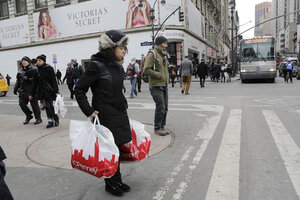US retail sales fall 0.6 percent as winter worries linger
Retail sales fell unexpectedly for the third straight month in February, according to the Commerce Department. February brought plunging temperatures and record snowfall to much of the US, and such conditions can be a particular drag on big-ticket retail purchases like cars and furniture.

A shopper carries JCPenney shopping bags, in New York. The Commerce Department reported a 0.6 percent drop in retail sales for February on Thursday, March 12, 2015.
Mark Lennihan/AP/File
Despite clear forward progress, signs that the resurgent economy’s spoils haven’t reached everyone still linger. Among the biggest concerns: most Americans just aren’t spending money.
Retail sales fell for the third straight month in February, according to data released Thursday by the Commerce Department, sliding 0.6 percent. Analysts widely had expected sales to rise, to about 0.4 percent. Over the past three months, retail sales have fallen 1.6 percent – the metric’s worst such stretch since early 2009 and the throes of the Great Recession.
Much of the swoon came from auto sales, which fell 2.6 percent. Excluding auto sales, overall sales dropped 0.1 percent. Some of that can be attributed to the weather: February brought plunging temperatures and record snowfall to many parts of the country, and such conditions can be a particular drag on big-ticket purchases like cars and furniture.
Still, many analysts expected that money to be spent elsewhere. “Pump prices are creeping up, and when people don’t buy autos they tend to spend it at stores and in restaurants,” IHS Global Insight economist Chris Christopher told the Monitor in a phone interview last week.
Indeed, gasoline spending jumped 1.5 percent last month, thanks largely to prices climbing back from surprising lows in at the tail-end of last year. Those low prices didn’t spur spending in other areas quite as much as expected. “The boost from lower energy prices looks to be fading more quickly than we had expected in the early part of 2015,” Barclays Research economist Jesse Hurwitz wrote in an e-mailed research note.
Even excluding volatile categories like gas and vehicle sales, however, the weakness in consumer spending could mean that the overall economy will not expand in 2015 at the rate economists expect. With the job market chugging along, too, that means the GDP growth will be a closely watched factor in when the Federal Reserve will finally raise interest rates. That’s widely expected to happen in early summer, but a weak consumer market could give policymakers pause.
“These worrying retail sales numbers, alongside weak inflation and wage growth trends, mean it’s likely that the Fed will delay any tightening of policy until a clearer picture of the economy emerges later in the year,” MFR, Inc. economist Chris Williamson writes via e-mail. Still, it’s possible retail spending will gradually improve as the job market continues to strengthen. Plus, Williamson says, it really could just be the weather.
“We should see some stabilization in the retail sales trend once the impact of the bad weather passes, and – like the three-month trend in core retail sales – data suggests the underlying trend in the economy is merely slowing to a more modest and sustainable pace rather than collapsing,” he writes.

